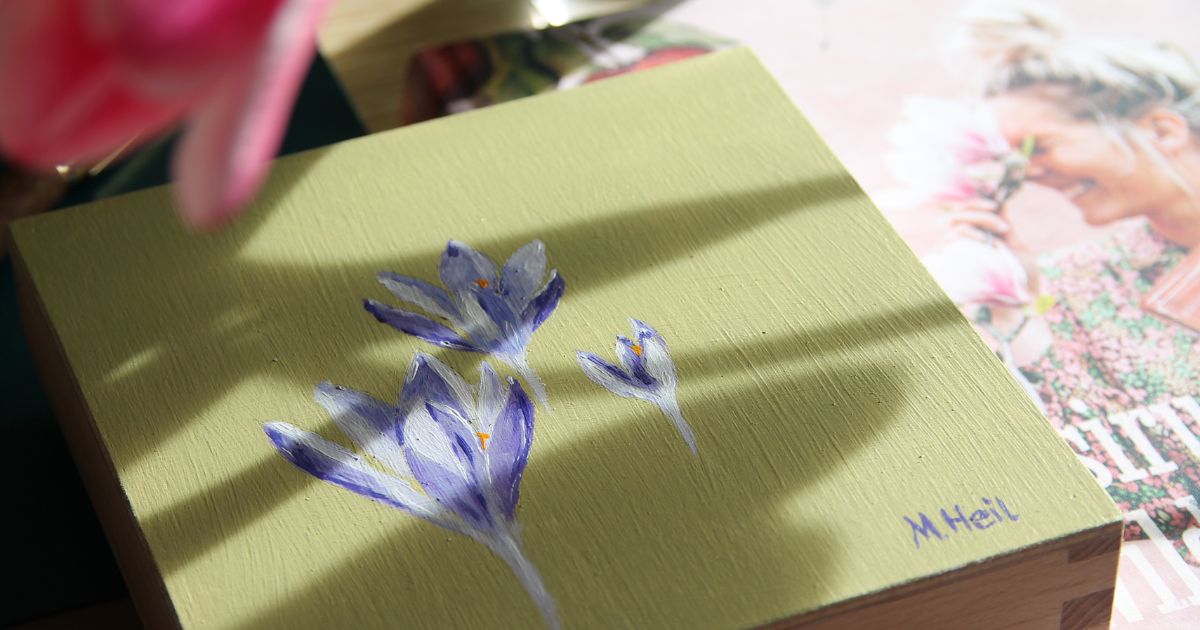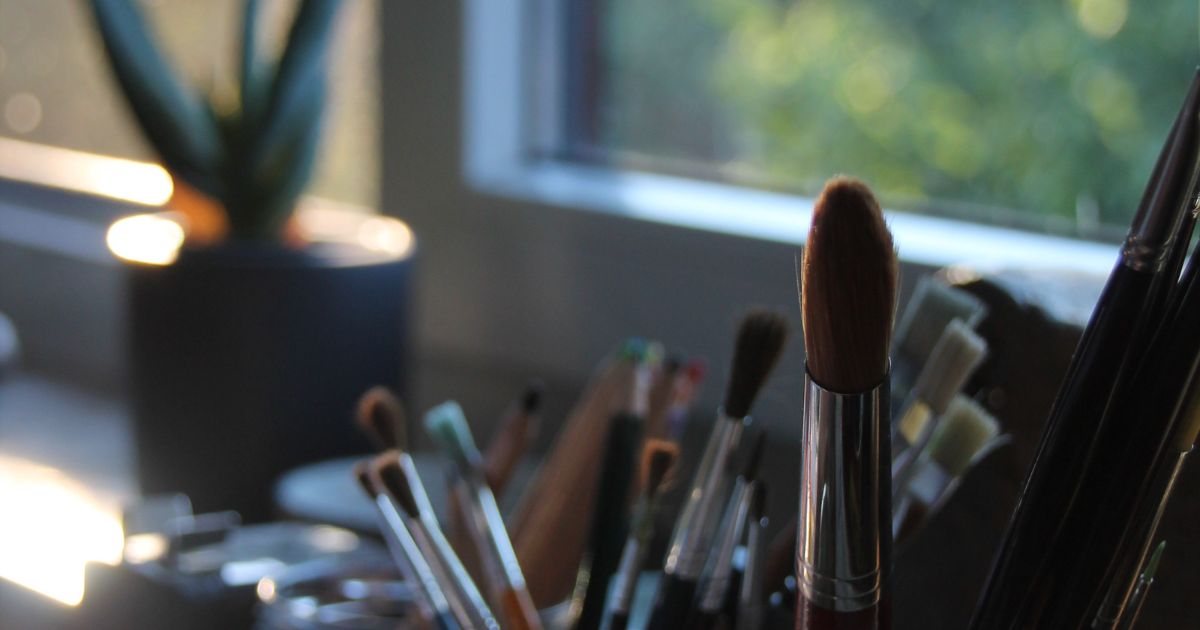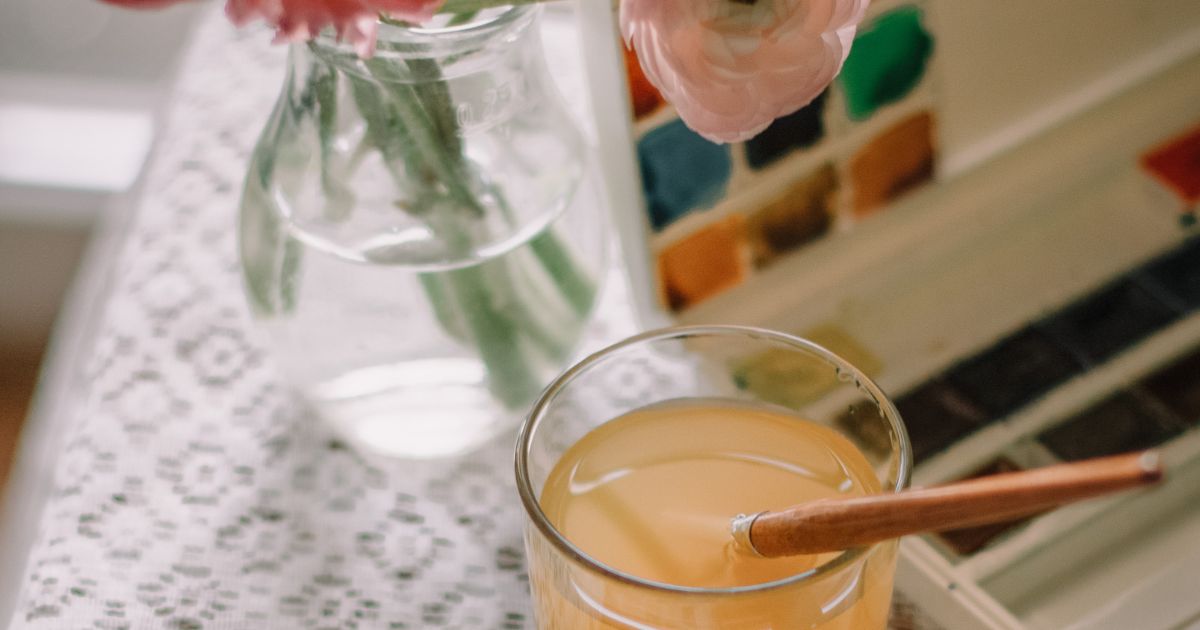When it comes to styling art, many people are puzzled about how to style artworks or fine art prints in their home, as we often imagine blank white walls (like the ones shown in trendy magazines or as we’ve seen on the mock-up photos used by many artists, to give you an idea about how their artwork looks with furniture). However, these huge white walls are mostly not the reality of our houses and especially if you buy small to medium sized art, they will simply look lost on a big white wall. So, here are my five interior tips on how to style your art at home.
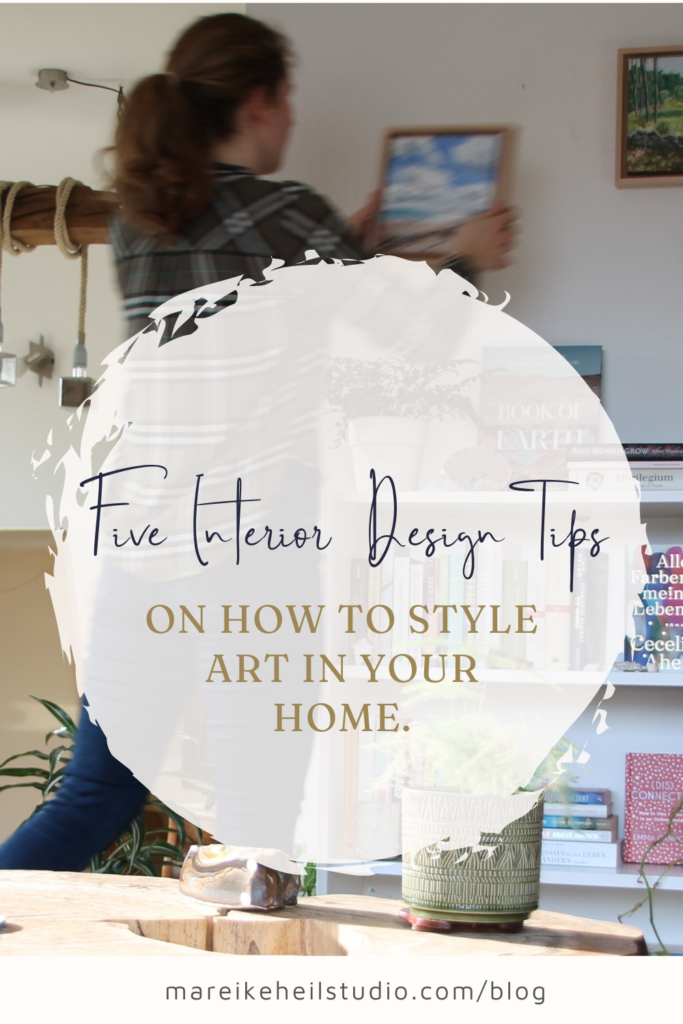
Interior Design Tips by an Artist?
Disclaimer: I’m not an interior designer nor am I a self-made expert in interior design. My home is styled through my very own sense of aesthetic (mixed with the likes of my partner). Styling our home is a very personal thing, as it reflects a part of ourselves. I know what works with (my) art from living with it, as I only have a small home studio and just hang all paintings to dry in my flat. Additionally, I dislike these mock-up photos for artists and rather take photos of my artwork styled in my own home. And what works for photos usually also looks good in real life.
And anyway, whose got big white walls to fit a 2×2 meters painting? I don’t and all people I know share having low to medium height walls. So, to have your artworks and fine art prints shine even in these spaces, here are my five tips.
Where Is the Difference Between Art on Paper or Art on Canvas?
The painting of an artist is usually either done on paper or on canvas. While at first it seems like it doesn’t matter because you just want this particular painting, on a closer look you should keep an eye on a few things that come with either one of them. In general, you should mind for both to not expose them to direct sunlight all year round, as that may lead to the colours fading or some materials changing its colour. For oil paintings in particular, take care to not put them in a dark corner because that may lead to the painting yellowing due to the linseed oil used to paint it.
Original Artworks or Fine Art Prints on Paper
Artworks or fine art prints on paper are usually displayed in a frame with acryl glass or glass, so they are usually not directly exposed to the environment which helps with taking care of them. However, there are all different kinds and qualities of glasses out there from simple acryl glass to museum quality that will break the sunlight in a way that it won’t damage the painting (expensive though!). You can also get glass that doesn’t reflect the light and some that does. It’s up to you which one you choose, but for most art, I would usually go for any medium quality frame and that’s it (but that also highly depends on the worth of your artwork).
Another way to display prints or art on paper is with poster bars. I would only do this for prints but find it really beautiful, nonetheless. It’s a modern way to hang posters, prints or art – even unstretched art or prints on canvas will do – and it looks just pretty.
A final note on fine art prints: There is a HUGE difference between a poster and a fine art print, when it comes to the quality of the paper or canvas and colours used. Fine art prints are (usually) giclee prints in archival quality, lasting a lifetime. So, do your favourite artist a favour and treat them like real art.
Artworks or Fine Art Prints on Canvas
These work a bit different, as they are directly exposed to the environment. You need to dust them every once in a while, and if they become very dirty, have them cleaned by a professional. You can’t put them behind glass (especially oil paintings don’t like that; they need to breathe), so there is nothing to protect them except the varnish applied by the artist or printer.
On the other hand, you don’t need to think about the glass in your frame with these and often they come pre-framed by the artist. If not, and you still want a wooden frame or have it changed, it’s best to take your piece of art to a professional framer, who knows how to work with paintings. Also, they won’t reflect the sun, you always have a good look at it from all sides.
Now, let’s do some interior styling for your piece of art!
Small Paintings Like to Hang in Groups OR Stand on a Shelf.
When it comes to art, let’s be honest, we often think about big canvases, being the centre of focus in a room. The major player of aesthetics, but I mostly paint small or medium sized paintings and they need to be styled in a different way. On an overcrowded wall, behind a huge plant, you probably wouldn’t notice a small painting and it has a hard time shining brightly. But alone on a wall makes it look equally weird, except you’re living the minimalist life.
However, the easiest way to style small paintings in your home is to arrange them either in a group or on a shelf. The great thing about small paintings is that you’re able to combine them with many other smaller artworks or prints and create a gallery wall. I looove gallery walls because you can mix and match and rearrange them just as you like. Below I sketched a few ideas on how to set up your gallery wall. The artworks or fine art prints don’t even have to be from the same artist or even show the same subject. Combine what you like and you’re probably building a wall that you’ll love and will always inspire you, as it shows pieces from artists that are important to you, and that is what makes it just perfectly right.
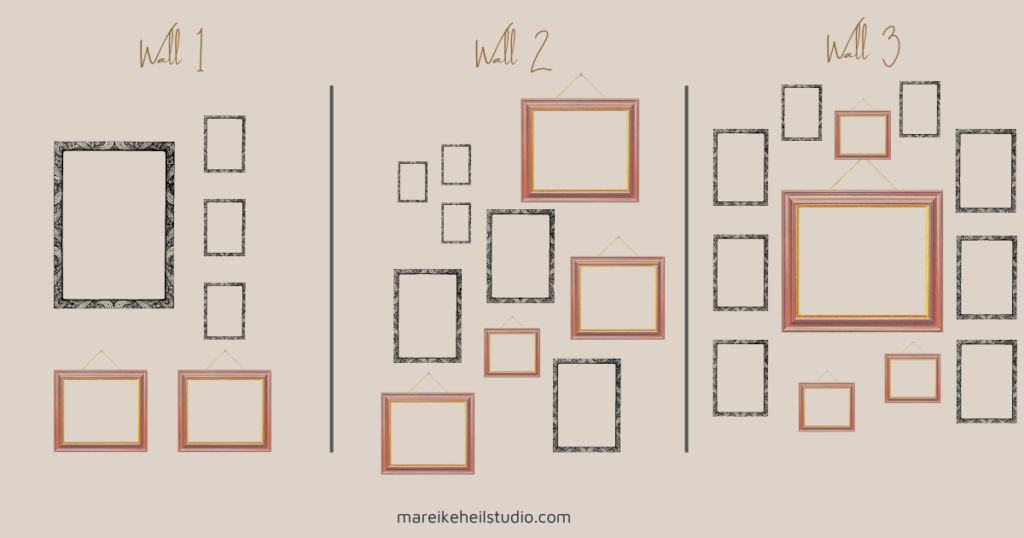
I’ve also created a Pinterest Board for Gallery Wall Inspiration. Feel free to check it out.
You don’t want a gallery wall but have a shelf? Here’s how to style it with your artwork.
But what if your gallery wall is already full or you don’t want to create one? Then my idea for you would be to find a decent shelf or commode in your home where the piece of art can live on. If your artwork is painted on paper you can look for a frame that can stand and if it’s painted on canvas you can have it framed so you can simply put it up there as well. Next to your artwork, try to arrange a vase with flowers or indoor plants (see below) or other decoration you love. Try to match a colour from the artwork to highlight it.
Little note: Many people love to hang art above their fireplace or put it on the mantelpiece, but I would try to avoid this. Stoves create a lot of dust and smoke rises occasionally (you might have noticed that the ceiling doesn’t stay bright white above it) which might damage your artwork or at least will leave a lot of dirt on its surface. Especially art on canvas wouldn’t love hanging there or it will need to get professionally cleaned one day (if possible). Art in a glass frame will probably do well, though you would need to clean the frame regularly.
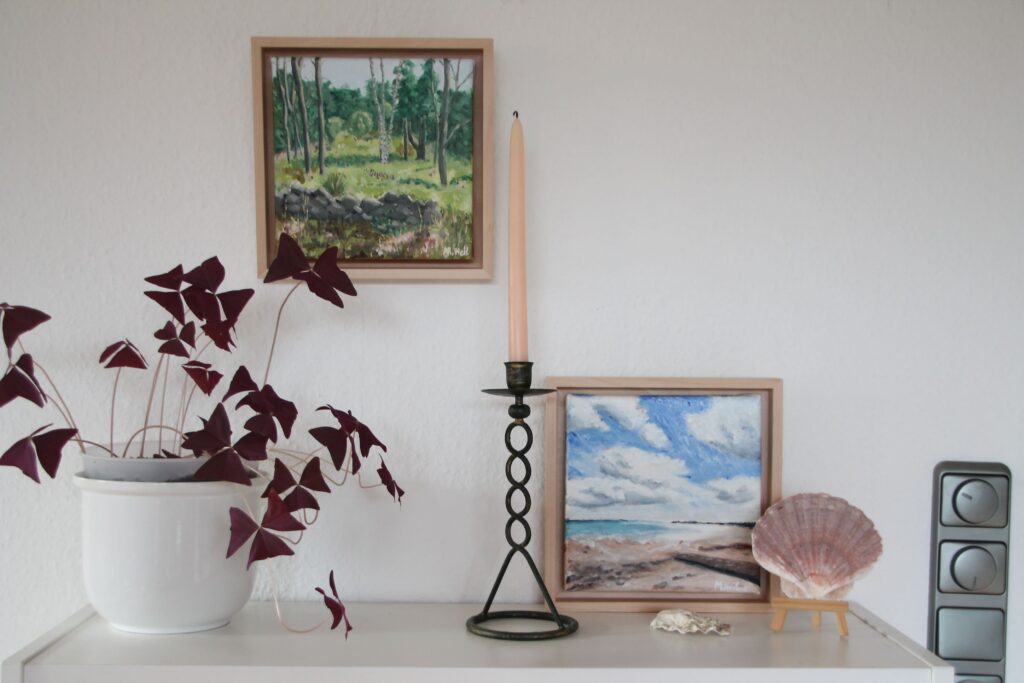
Plants for Your Art at Home
I’m a plant-lover. They’re all over my place, sit in corners, on shelfs, on the floor, dangling from the ceiling, so my art always ends up close to a plant. While you might have already come up with styling you artwork or fine art print with a nice vase and some cut flowers, which looks pretty indeed, I would rather say: Let’s buy a plant and pot that matches your artwork! Yeeei!
You’re in need of an example? Ok. So, when I wanted to photograph my artwork Savour the Liveliness, which is a small oil painting (20×20 cm) and shows a bight forest glade, I started to run around my home with it, to see which plant will fit it well. I wanted to take this forest feeling outside of the painting and see it come to live because that is what plants can do for paintings. Back then, I took my little asparagus in a brown pot and arranged it next to it. Then it look a little bit like a small tree or giant fern (sadly, I didn’t have actual fern back then).
So basically, you try to find a plant that either matches a colour or structure with your painting, or that is able to take a feeling or vision – that you have! – from the painting and make it come alive. It’s magical and truly beautiful. Plant pots can also work great with prints of your art or original artworks – again mind the colour matching.
To the Booklovers!
There is always too little wall for too many bookshelves, right? (If you want more books, look up my must-read books over here 😉 ) And then you also want to have art, prints or posters on your walls! I know this struggle, trust me. Pretty good then when you buy small paintings, which fit perfectly into bookshelves. Below, I’ll show you some ideas on how to arrange books and art.
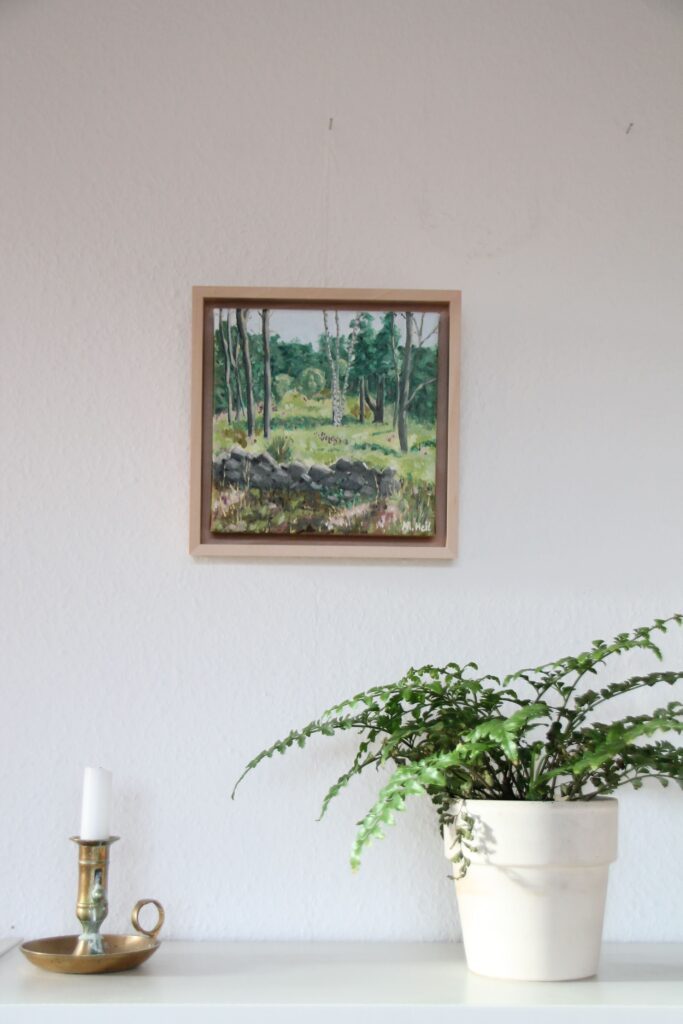
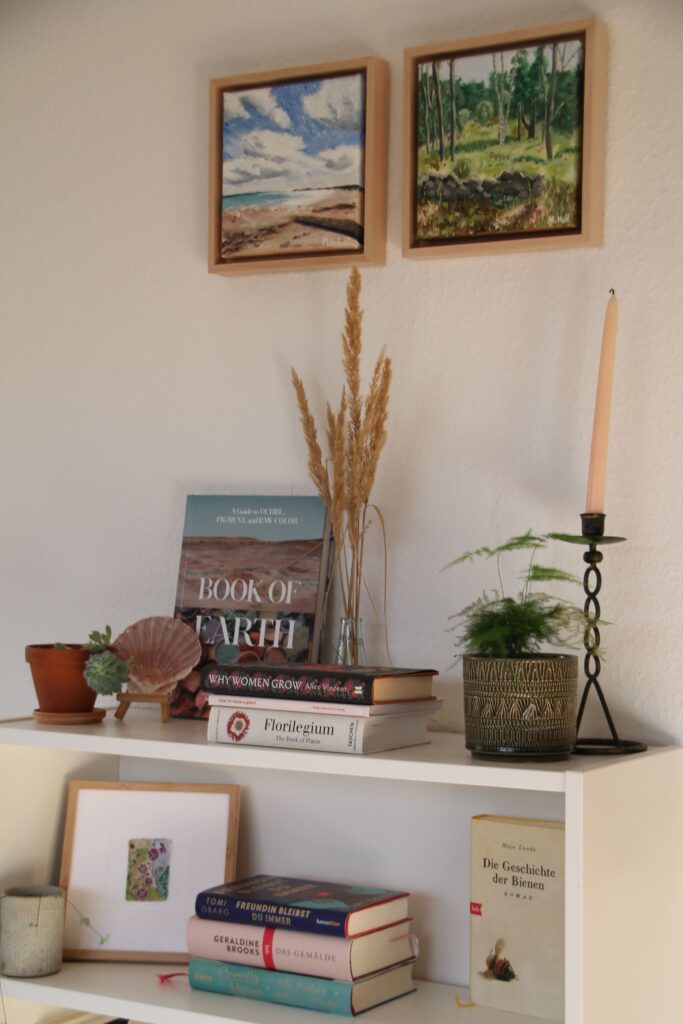
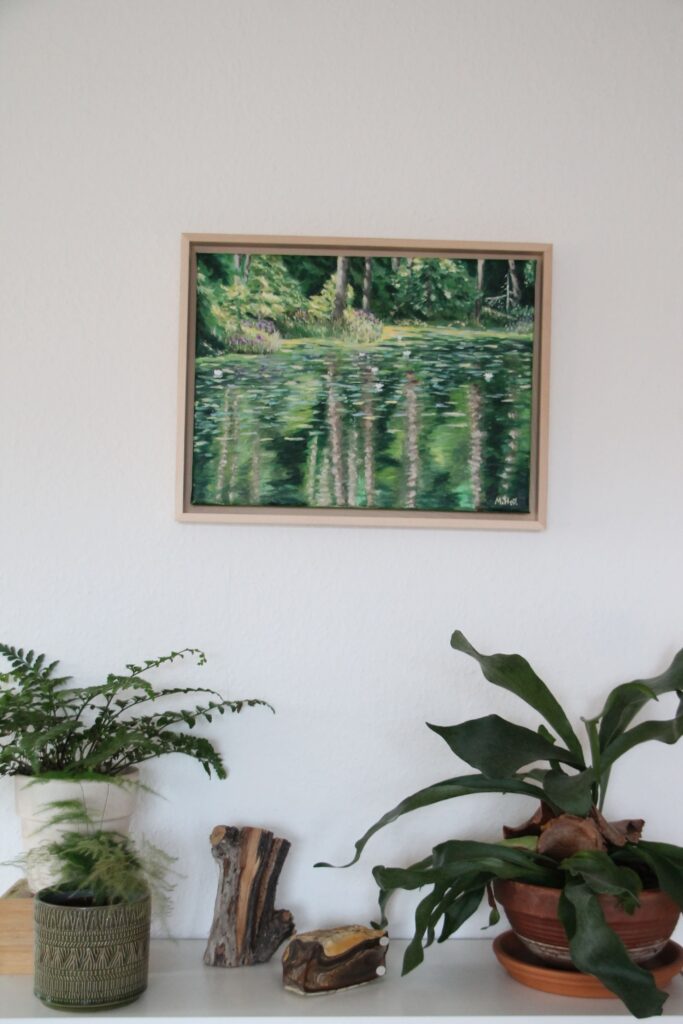
Cozy with Candles.
This is for the ones who love it cozy and romantic and at ease or a little witchy. I don’t like open fire – candles – in my home and never light one, but I know so many people who love them, and art looks incredibly good with a candle next to it. The easiest way to style an artwork is probably to place it on a commode, adding a flower bouget on one side and a candle on the other. Very classy, very decent, eyes on the artwork, even for minimalists, always beautiful.
Which one is the right candle? That heavily depends on your overall interior style, but also on the size of the painting. I’d suggest: If it’s a bigger painting a rather solid candlestick or candle will look great, while a small painting will look better with a small candle or short candlestick. Medium sized art goes well with thinner, long candlesticks or candles. But in the end, it’s very much up to you and your style.
Big Paintings Don’t Want to Stay All Alone.
Let’s come back to the huge white wall with a big painting. Maybe you have walls that can carry the massiveness of a big painting, but then still don’t leave it alone on this empty white wall. It might be the focus of the room then, but what is missing is probably your personality shining through and making your home feel like a place where you live, giving it coziness and that special blink with the eye. You don’t want to live in a mock-up, I guess.
So, you’ve got that big artwork and a huge wall. But what to add? Commodes are nice furniture pieces, vases on the floor with dried flowers will do, bigger plants (see above) or a little coffee table nook next to it, with pillows and a blanket. Maybe a thin glass cabinet with selected books or nice bottles of gin or whiskey (maybe you like those?), or you could add a few small sized paintings or prints on one side. There are endless options. I personally like bigger sized paintings or prints in the dining room area because they often fit the lengthy style of a dining table with a centre piece lamp very well.


